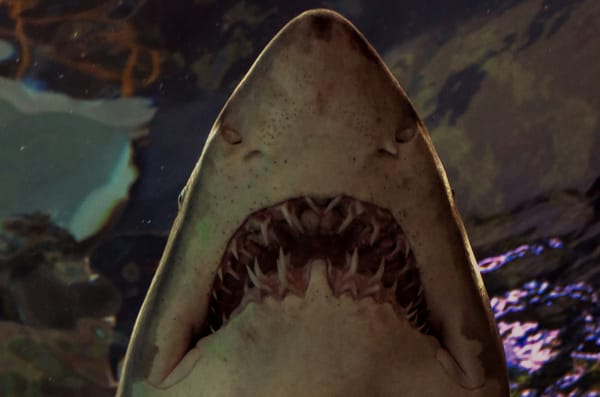The Frog Pond #19: Perplexing Pandas
What do pandas have in common with anteaters, gorillas, and geese? And why would a bear eat so much bamboo?

Welcome to June!! The best month!!
Why do giant pandas eat bamboo?
I used to think that giant pandas are bears only in name and didn't think much on their unusual bamboo diet. But pandas are bears as much any other ursidae family mammal. Most bears are omnivores, with the exceptions of the polar bear as hypercarnivores (eating more than 70% meat1) and the giant panda as herbivores (eating 99% bamboo shoots2).
(Red pandas, on the other hand, share a common ancestor to bears but are not part of/descendants of bears. They're genetically closer to striped skunks, racoons, polecats under the superfamily Musteloidea3 and equally close to common seals of all things under the clade Arctoidea4!)
What caused this plant-based shift in diet from their bear cousins?
Hard and soft tissue tell different diet stories
Pandas have adapted to eating bamboo, but not entirely. Pandas have a false thumb (a wrist bone) to handle bamboo, highly developed muscles to chew, and large but flat molars to crush vegetation, but their digestion system still resembles carnivores5.
Pandas have to eat a LOT of bamboo (over 14 hours of eating a day!) to process enough protein because their digestion system isn't well adapted to tough, fibrous foods like bamboo that need longer to break down5.
Basically: Panda mouths? Great at eating bamboo. The rest of the panda? Not so much.
When did pandas go veggie?
The oldest known species of panda that resembles it is the Kretzoiarctos beatrix, believed to have lived during the Miocene epoch (23 - 5 million years ago)6. There are other extinct species of panda, but K. beatrix has a great name and the cutest Wikipedia illustration:

K. beatrix was a small herbivore in what's now Spain that ate very hard plants6. Its tooth structure suggests the beginning of the much more complex molar structure in giant pandas today7.
Many fossils of extinct panda species are incomplete and only identified through molar teeth, so the moment an ancient bear saw bamboo and decided to give up its meat-eating way isn't certain.
The fossil record suggests a mosaic evolution in the panda lineage. This is when changes in a species happen in some parts of the body but not others, and at different rates, between animals of a species. The classic example of this is Darwin's finches, 18 sub-species of finch with different beak forms and functions that evolved to facilitate different food sources8.
Pandas are wolves in sheep's grazing
Wild giant pandas graze bamboo, eating some parts but not others, to maximize dietary protein and minimize fiber9. 48 - 61% of their nutritional energy is from the bamboo protein, as opposed to most herbivores that get most of their energy from the fiber thanks to microbial fermentation in their gut. This makes pandas' energy consumption similar to the protein-energy of hypercarnivores instead (for example, cats get about half their energy from protein)10 despite it being plant-derived.
Given most bears are omnivores, it's an interesting puzzle: Why do pandas eat so selectively of their primary food source, especially compared to the plant matter that other bears eat? There are a few theories:
- They might avoid the cardboard-like portions of bamboo they don't like to eat that happen to be 80-90% fiber5.
- They might avoid silica-rich portions that can inhibit digestion and wear their teeth11. Wear on molars is an important part of a panda's overall health, as dental problems in the closely-related Qinling pandas have been found to have an impact on their survival rate12.
- The only way to keep their diet high-protein is to digest as little fiber as possible, which the giant panda is very good at avoiding. Not many mammals specialize in bamboo, so pandas have a monopoly on the quick-growing plant. So while bamboo is a poor nutritional source for most herbivores due to how hard it is to digest into useful fiber for microbial fermentation, it's great for an animal that only wants to absorb its protein5.
Duck, duck, duck... panda
What at first seems like an incredibly inefficient nutritional process starts to make more sense with the third theory and a wider context.
Like anteaters to insects and soil, pandas have digestible and non-digestible parts to their diet13.
Like a gorilla, pandas have low metabolic rates that help them subsist on poor nutrition14.
And like barnacle geese, whose flight would be hindered with large digestive fermentation chambers, they don't digest plant fiber efficiently15.
Stories like the panda always fascinate me. There's a logical path from omnivore to herbivore even if at first it seems nonsensical. It might not be the system you or I might have designed, but it's the path that evolution happened to take. Giant pandas are the min-maxers of the animal world, using a broken build from extremes in the dietary spectrum to munch on bamboo all day long.
How are pandas doing?
There are others aspects of panda biology that this nutritional method effects including their reproductive biology, where a panda can only successfully conceive for 2-3 days out of a whole year (one of many reasons that panda breeding programs are famously difficult)16 in part due to them not being able to devote their limited energy to reproduction.
In the 1980s as few as 1,114 wild pandas were living in China, declining mainly due to habitat lost, deforestation, low birth rate, and climate change17 (though a 2006 study argues that the old method of population surveying may have been an underestimate18).
As of July 2021, giant pandas are no longer considered endangered in the wild thanks to successful global conservation efforts, but they're still reliant on human conservation to counteract poaching, deforestation, and the continued effects of climate change. Their wild population now exceeds 1,800 thanks to decades of advocacy and nature reserves specializing in accommodating pandas19.
To close off, here's a photo of giant panda cub Xiao Liwu (meaning "little gift"), taken before his first birthday at the San Diego Zoo. Xiao Liwu was moved to China in April 2019, but you can find live footage from the zoo's website of him and his family from his time there.

A word from a passing frog
I got some not-great news on the job search front this month that meant an opportunity I thought I'd been offered was not, in fact, happening. I'm hoping this is one of those "seemed like a bad thing but led to a good thing" situations. I've got some other leads I'm chasing, so please cross your fingers for me!
On the bright side: I'm swimming again! I've missed it a ton. And it's my birthday month!
Writing
I've been working on my adult fantasy dark academia book! I'm putting a lot of time into my pre-writing and outlining phase to make sure I'm writing the book I've been envisioning with the themes and bite it needs.
Publishing
I'm sorry that all I can say is :) for now but !!!
Reading
I finished Moon of the Turning Leaves by Waubgeshig Rice that I'd mentioned last month (so highly recommend!!) as well as:
Annihilation by Jeff VanderMeer: A very fun re-read of the ecohorror novel that got me wanting to write my own back in 2017. I love it just as much now as I did then. It's fascinating to read the same book when I'm such at different stages of my writing craft!
The Only Good Indians by Stephen Graham Jones: Man! This book was such a cool weaving of narrative voices and plot lines. I loved the sections following the "antagonist" (I won't spoil anything!) and the dreamy language in a few of the scenes, and I especially loved the first third-ish of the novel.
I'm 83% of the way through Dune by Frank Herbert, which I can't believe I've taken so long to read. I was intimidated by how people talk about it--but I love it! It's getting me out of a small reading slump and I can't believe how easily I've been getting through such a long book.
Please share The Frog Pond with friends that you think would enjoy this kind of nature deep-diving! Thank you for reading :-)
Footnotes
1: https://zslpublications.onlinelibrary.wiley.com/doi/10.1017/S0952836904004856
2: https://archive.org/details/earthschangingen0000comp/page/49
3: https://academic.oup.com/sysbio/article/67/1/127/3796842?login=false
4: https://academic.oup.com/sysbio/article/54/2/317/2842927?login=false
5: https://www.sciencedirect.com/science/article/pii/S0960982219304749
6: https://revistas.ucm.es/index.php/JIGE/article/view/44083
7: https://www.ncbi.nlm.nih.gov/pmc/articles/PMC3498366/
8: https://doi.org/10.1641%2F0006-3568%282004%29054%5B0501%3Abaavei%5D2.0.co%3B2
9: https://journals.plos.org/plosone/article?id=10.1371/journal.pone.0068714
13: https://zslpublications.onlinelibrary.wiley.com/doi/10.1111/j.1469-7998.1984.tb02345.x
15: https://www.jstor.org/stable/2389753?origin=crossref
16: https://web.archive.org/web/20080807161537/http://www.4panda.com/panda/pandatips/reproduction.htm





